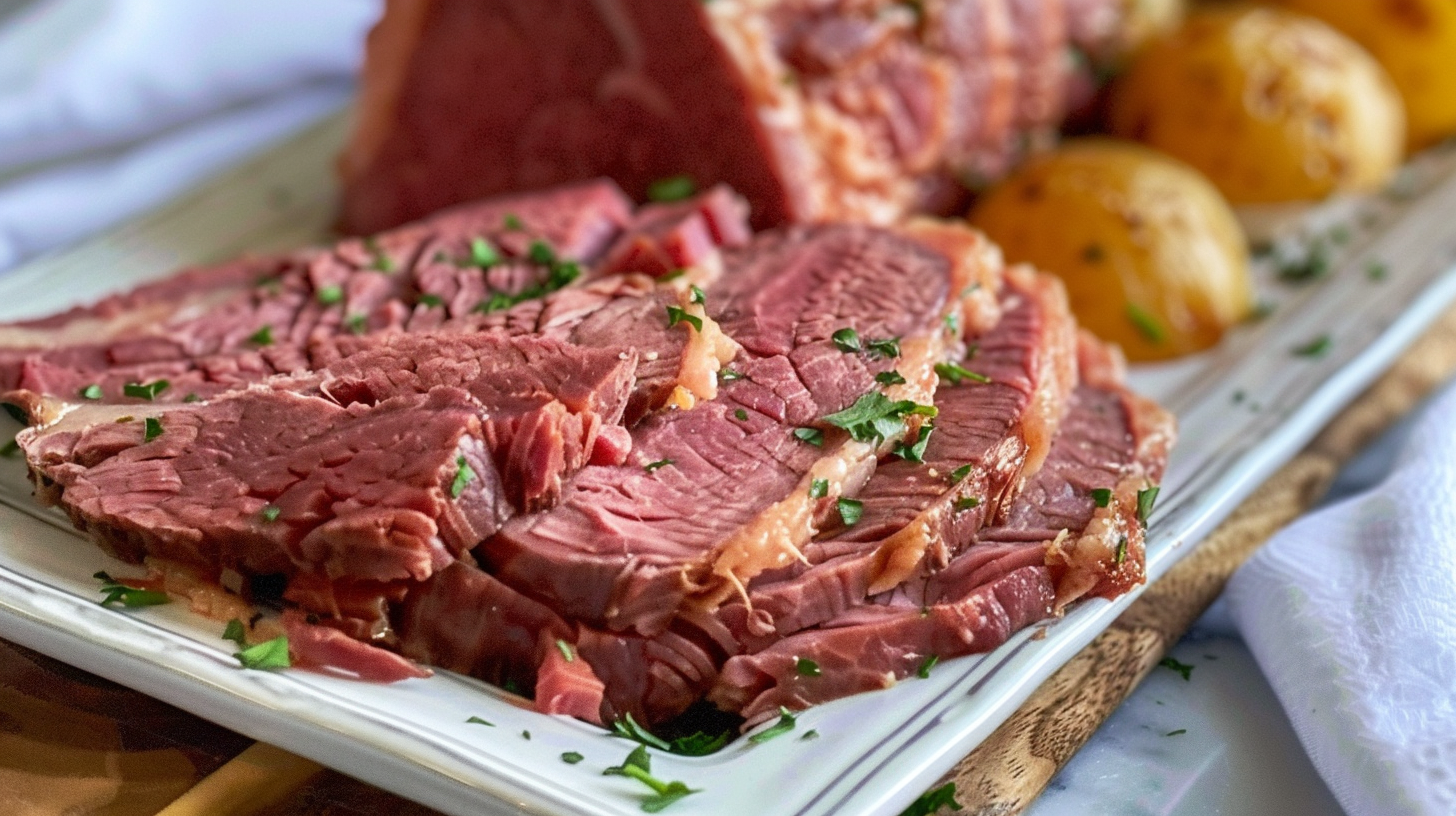Discovering the Rich Flavor of Beef Shank
Beef shank, a cut from the legs of a cow, is known for its rich flavor and tough texture. When cooked slowly, it softens beautifully, transforming into a tender, flavorful dish. Typically, a beef shank recipe involves braising or slow cooking in liquid. This breaks down tough muscle fibers and connective tissues. The cooking process often includes savory broth, herbs, and vegetables. These ingredients enhance the taste and create a hearty sauce or gravy. Beef shank is perfect for comfort foods like osso buco, stews, and soups. It offers a satisfying depth of flavor, enriched by the marrow in the bone. This cut is also economical, making it a popular choice among budget-conscious cooks. It allows them to serve a delicious, meaty meal that is both filling and nutritious.
Now, let’s explore a recipe for “Braised Beef Shank with Root Vegetables.” This dish is celebrated for its robust flavors and comforting warmth, especially appealing in the colder months.
This recipe is interesting for several reasons:
Cultural Significance of Braised Beef Shank Dishes
Braised beef shank is a staple in many cuisines worldwide. It appears in dishes like the Italian “Osso Buco” and the Chinese “Red Cooked Beef Shank.” This recipe takes inspiration from European-style slow cooking. It integrates root vegetables often harvested in the fall and winter. This aligns with traditional practices of using seasonal, local produce.
Health Benefits of Slow-Cooked Beef Shank
Beef shanks are rich in protein and contain essential nutrients like iron and zinc, crucial for a healthy immune system and muscle building. The slow cooking process in braising makes these nutrients more bioavailable by breaking down connective tissues. Moreover, adding root vegetables such as carrots, parsnips, and turnips increases the dish’s fiber, vitamins, and antioxidants, enhancing its nutritional value.
Seasonal Cooking with Braised Beef Shank
As a dish that requires slow cooking, it is perfect for colder seasons. The warmth of the oven and the steamy, aromatic environment it creates in the kitchen make it an ideal recipe for autumn and winter when the body craves more substantial, comforting meals. The use of seasonal vegetables also maximizes the flavor and nutritional content of the dish.
How Beef Shank Meets Dietary Preferences
This recipe is suitable for those on a gluten-free diet, as it contains no gluten. It provides a hearty meal without needing bread or other gluten-rich sides. Its rich flavors and satisfying texture also attract those seeking fulfilling meals without processed foods.
Combining cultural depth with nutritional benefits and seasonal suitability, this recipe offers a delicious way to enjoy a hearty meal. It nourishes both the soul and the body.
Here’s the list of ingredients needed for the Braised Beef Shank with Root Vegetables recipe. Important notes about specific ingredients are also included:
Ingredients:
- Beef Shank: 4 large pieces, about 1 inch thick each
- Salt and Black Pepper: To taste
- Olive Oil: 2 tablespoons
- Onion: 1 large, chopped
- Garlic: 4 cloves, minced
- Carrots: two large, peeled, and sliced into pieces
- Parsnips: 2 large, peeled and cut into chunks
- Turnips: 2 medium, peeled and cubed
- Red Wine: 1 cup (substitute with beef broth or grape juice if avoiding alcohol)
- Beef Broth: 4 cups, preferably low sodium
- Tomato Paste: 2 tablespoons
- Bay Leaves: 2
- Thyme: 1/4 cup fresh or 1 teaspoon dry
- Rosemary: One tablespoon fresh or one teaspoon dry
Important Notes:
- Organic Ingredients: Using organic beef and vegetables can help avoid the intake of pesticides and hormones. Organic beef is particularly recommended for better flavor and nutritional quality.
- Allergen Substitutions:
- Wine: If you can’t drink alcohol, you may simulate the acidity of the red wine by adding more beef broth or combining grape juice with a tablespoon of vinegar in place of the red wine.
- Olive Oil: If allergic to olive, consider using avocado oil or another vegetable oil that tolerates high heat.
- Beef Shank: Ensure that the beef shank pieces include the bone, as bone marrow contributes significantly to the richness of the broth.
- Root Vegetables: You can substitute any of these root vegetables with others like sweet potatoes or celery root depending on availability and personal preference.
By paying attention to these notes, you can tailor the dish to meet dietary needs and preferences while maximizing flavor and nutrition.
Here is a detailed step by step guide to preparing and cooking Braised Beef Shank with Root Vegetables:
Equipment Needed:
- Large oven safe Dutch oven or heavy-bottomed pot with a lid
- Sharp knife and cutting board
- Measuring cups and spoons
Preparing and Cooking Braised Beef Shank with Root Vegetables:
Preheat the Oven:
- Preheat your oven to 163°C. This moderate temperature allows for slow and gentle braising.
Prepare the Beef:
- Season the beef shank pieces generously with salt and black pepper on both sides.
- In the Dutch oven, heat two tablespoons of olive oil over medium high heat.
- The beef shanks should be seared for three to four minutes on each side, or until they are well browned on both sides. After taking the beef shanks out of the saucepan, put them aside.
Sauté the Vegetables:
- Include the chopped onion and minced garlic to the same saucepan. For approximately five minute, or until the onion becomes transparent, sauté.
- When the veggitables start to soften, add the chopped turnips, parsnips, and carrots and simmer for a further five to seven minutes, stirring now and again.
Deglaze the Pot:
- Add one cup of red wine (or a good substitute) to the pot to deglaze it, then scoff any browned bits from the bottom with a wooden spoon. Let the wine reduce by half for about five minutes.
Add Liquids and Seasonings:
- Once the tomato paste is well mixed with the veggies, stir it in.
- Add the beef broth, bay leaves, thyme, and rosemary. Bring the mixture to a simmer.
Braise the Beef:
- Put the seared shanks of meat back in the saucepan. The liquid should come about halfway up the sides of the beef shanks; add more broth if necessary.
- When the liquid has simmered again, put the pot back into the oven that has been prepared.
- For a highly soft and effortlessly falling off the bone beef, braise in the oven for 2.5 to 3 hours.
Final Adjustments and Serving:
- Remove the pot from the oven. Discard the bay leaves and any herb stems if you used fresh herbs.
- Taste the soup and, if necessary, add additional salt or pepper to suit your taste.
- Spoon the veggies and broth on top of the meat shanks and serve. For soaking up the wonderful broth, this recipe works nicely with polenta, crusty bread, or mashed potatoes.
Tips for Cooking Braised Beef Shank:
- Browning the Beef: Don’t skip browning the beef shanks as it adds a deep flavor to the overall dish.
- Slow Cooking: Make sure to cook the beef shanks slowly and gently; rushing this process can result in tough meat.
- Resting: Let the dish rest for about 10 minutes after removing it from the oven to allow the flavors to meld together better.
Variations and Substitutions for Braised Beef Shank:
This method of preparation ensures that the beef shank, a tougher cut of meat, is transformed into a tender, flavorful dish complemented by hearty vegetables and a rich, savory broth. Enjoy your cooking!
To accommodate different tastes and dietary restrictions, here are some possible variations and substitutions for the Braised Beef Shank with Root Vegetables recipe:
Gluten-Free Adjustments:
- Ensure Broth is Gluten-Free: Not all store-bought broths are gluten-free as some may contain additives or flavorings with gluten. Always check the label or use homemade broth to be safe.
- Watch for Hidden Gluten in Other Ingredients: While most of the other ingredients naturally do not contain gluten, it’s important to use wine or tomato paste that has been certified gluten-free if there are concerns about cross-contamination.
Vegan and Vegetarian Variation:
- Substitute for Beef Shank: Replace the beef shanks with large, hearty chunks of portobello mushrooms, or use seitan for a high-protein alternative. You can also consider using jackfruit for its meaty texture, though it’s softer and won’t mimic the chew of beef as closely.
- Vegan Broth: Use a robust vegetable broth or mushroom broth instead of beef broth to maintain the savory depth of the dish.
- Additional Proteins: Incorporate beans or lentils for added protein and texture. Adding these towards the last 30 minutes of cooking will prevent them from becoming too mushy.
- Increase Vegetables: You can bulk up the dish with more varieties of root vegetables or add other vegetables like squash or sweet potatoes for additional flavor layers.
Low-Carb/Keto Adjustments:
- Reduce Root Vegetables: While root vegetables are central to this dish, they are high in carbs. Replace them with lower-carb alternatives like radishes, celery root, or cauliflower.
- Increase Fats: You might want to increase the amount of olive oil or add other fats like butter for cooking to align with keto dietary fat intakes.
No-Alcohol Substitution:
- Alternative to Wine: Instead of red wine, use a combination of red wine vinegar (just a splash) mixed with either more broth or a non-alcoholic red wine substitute to achieve a similar flavor profile without the alcohol.
Allergy-Friendly Adjustments:
- Substitute for Allergens: If there are specific allergies to consider, such as to garlic or onions, these can be omitted or replaced with allergy-friendly alternatives like asafoetida powder (which mimics the flavor of onions and garlic) or simply use other herbs to enhance the flavor.
These variations and substitutions allow you to tailor the Braised Beef Shank with Root Vegetables recipe to meet a variety of dietary needs and preferences while maintaining its comforting and hearty essence.
Nutritional Breakdown of Braised Beef Shank with Root Vegetables:
To provide a nutritional breakdown of the Braised Beef Shank with Root Vegetables recipe, let’s consider typical ingredients and their contributions to the dish. Below is an approximate analysis based on the ingredients listed earlier, which serves as a useful guide to understanding its dietary benefits and considerations:
Nutritional Breakdown (Per Serving):
Assuming this recipe serves 4, here’s an estimated nutritional content for each serving:
- Calories: 450-500 kcal
- Protein: 40-45 grams
- Fat: 20-25 grams
- Saturated Fat: 6-8 grams
- Carbohydrates: 25-30 grams
- Dietary Fiber: 6-8 grams
- Sugars: 8-10 grams
- Cholesterol: 100-120 mg
- Sodium: 300-500 mg (varies greatly depending on the sodium content of the broth used)
Dietary Benefits:
- High in Protein: Beef shank is a fantastic source of high quality protein, which is essential for muscle repair, growth, and overall body function.
- Rich in Minerals: With so much iron and zinc in beef, this meal is a great source of both. Zinc helps the immune system and iron is essential for making red blood cells.
- Vitamins: Root vegetables provide vitamins like Vitamin A (from carrots), which is important for vision and immune function, and Vitamin C (from parsnips), which aids in iron absorption and is an antioxidant.
- Dietary Fiber: The root vegetables also contribute a good amount of fiber, which helps in digestion and maintaining a healthy gut.
Dietary Considerations:
- Low in Sugar: This meal is relatively low in sugars, which makes it a good option for those managing blood sugar levels.
- Moderate Fat Content: While this dish contains fat, mainly from the beef and olive oil, it provide a balance of saturated and unsaturated fats. However, for those monitoring fat intake, especially saturated fat, portion control is advised.
- Gluten-Free Potential: By ensuring that all broth and other ingredients are gluten-free, this dish can be made suitable for those with gluten intolerance or celiac disease.
- Adjustable Sodium Content: Using low-sodium broth or making your own can help control the sodium content, which is beneficial for those with high blood pressure or cardiovascular concerns.
This breakdown offers a comprehensive view of the nutritional landscape of the Braised Beef Shank with Root Vegetables, highlighting its strengths as a hearty, nutritious meal while also pointing out areas where adjustments can be made to meet specific dietary needs.
Pairing the right dishes and drinks with Braised Beef Shank with Root Vegetables can elevate your meal experience. Here are some recommendations for side dishes, wine pairings, and complementary courses that harmonize well with this hearty dish:
Side Dishes:
- Creamy Polenta: A smooth and creamy polenta serve as a perfect base to soak up the rich, flavorful sauce of the braised beef.
- Garlic Mashed Potatoes: The creamy texture and garlic flavor make mashed potatoes a comforting side that complements the savory depth of the beef shank.
- Crusty Bread: Fresh, warm bread is ideal for dipping into the succulent broth and savoring every last drop.
- Steamed Green Beans or Broccoli: A simple side of green vegetables adds color and a crisp texture to the meal, balancing the tenderness of the meat.
Wine Pairings:
- Barolo or Barbaresco: These Italian red wines, made from Nebbiolo grapes, offer tannic robustness and deep flavors that stand up well to the rich, meaty flavor of braised beef.
- Cabernet Sauvignon: A full-bodied Cabernet Sauvignon complements the richness of the beef with its own structure and hints of dark fruit.
- Chianti Classico: The acidity and tannins in Chianti Classico cut through the fattiness of the dish, balancing the palate beautifully.
Complementary Courses:
- Starter: Begin with a simple arugula salad dressed with olive oil, lemon, salt, and shaved Parmesan. This light starter prepares the palate without overwhelming it before the main course.
- Soup: A bowl of roasted tomato soup can be a warming and acidic complement to the richness of the main dish, offering a smooth transition in your meal.
- Dessert: For dessert, choose something light and refreshing to cleanse the palate, such as a lemon sorbet or a poached pear.
Drinks:
- Beer: If you’re more of a beer drinker than a wine drinker, go for a dark brew or stout; they have the strength to complement the taste of the meat.
- Non Alcoholic Options: A sparkling apple cider or a robustly flavored kombucha (such as ginger or berry) can provide a festive and refreshing accompaniment without alcohol.
Each of these suggestions is designed to complement the flavors and textures of the Braised Beef Shank with Root Vegetables, creating a well-rounded dining experience. Whether choosing a side, a drink, or planning the full course, these pairings aim to enhance the enjoyment of your meal.
questions
- Personal Touches: Have you tried making this Braised Beef Shank recipe at home? If so, what personal touches or tweaks did you add to make it your own?
- Ingredient Substitutions: Did you make any substitutions to the ingredients list that worked particularly well? For example, did you use a different type of broth or add any unique spices?
- Serving Suggestions: What are your favorite side dishes to serve with this braised beef shank? Do you prefer traditional sides like mashed potatoes, or do you pair it with something less conventional?
- Wine Pairings: If you paired this dish with a wine, which one did you choose? How did it complement the flavors of the beef and vegetables?
- Cooking Tips: Do you have any specific tips for achieving the perfect tenderness and flavor when braising beef shank? What are your secrets for the best results?
- Dietary Adjustments: How have you adapted this recipe to meet dietary needs, such as making it gluten-free, vegan, or low-carb? What were the outcomes?
- Family and Friends’ Reactions: How did your family or guests react to this dish? Was it a hit at your dinner table?
- Leftover Ideas: Do you have any creative ideas for using leftovers from this recipe? How do you enjoy the braised beef shank the next day?
- Cultural Variations: Are there similar dishes in your cultural background that resemble Braised Beef Shank with Root Vegetables? How do they compare in preparation and taste?
Frequently Asked Questions (FAQs) about beef shank recipe
What is beef shank and where can I find it?
Beef shank is a cut from the leg portion of a steer or heifer. Due to its high connective tissue content, it is best suited for slow cooking method like braising. You can find beef shank at most butchers and many grocery stores, especially those with a good selection of meat cuts.
Is it possible to use an Instant Pot or slow cooker in place of an oven?
Yes, you may modify this recipe to fit in an Instant Pot or slow cooker. For the slow cooker, follow the recipe up to the point of braising and then transfer everything into the slow cooker. Cook on low for 8-10 hours or on high for 4-5 hours. For the Instant Pot, use the sauté function to brown the meat and sauté the vegetables, then switch to the pressure cook setting and cook under high pressure for about 90 minutes.
What can I substitute for red wine?
If you prefer not to use red wine, you can substitute it with equal amounts of beef broth, diluted balsamic vinegar (1 part vinegar to 2 parts water), or non-alcoholic red wine. Adding a tablespoon of vinegar to the broth can help mimic the acidity of the wine.
How can I turn this recipe vegan or vegetarian?
To make a vegetarian or vegan version of this dish, substitute the beef shanks with mushrooms (like portobello), jackfruit, or a meat substitute like seitan. Use a hearty vegetable broth instead of beef broth, and ensure any other ingredients like wine are suitable for vegans.
How long can I store leftovers, and how should I reheat them?
For up to three to four days, leftovers may be kept in the refrigerator in an airtight container. Reheat them in the microwave or on the stove over medium heat until well warmed. You can even freeze the meal for up to three months; just defrost it in the fridge the night before reheating.
What are some tips for ensuring the beef is tender?
For the most tender beef, it’s important not to rush the cooking process. Low and slow is the key. Make sure the oven temperature is controlled and that the beef is submerged at least halfway in the liquid during braising. Also, allow the meat to come to room temperature before searing to ensure it cooks evenly.
Can I prepare this dish in advance?
This dish is perfect for making ahead as the flavors continue to develop when left overnight. Prepare the dish as directed, allow it to cool, and then store it in the refrigerator. Reheat gently when ready to serve, which makes it even more practical for entertaining.







